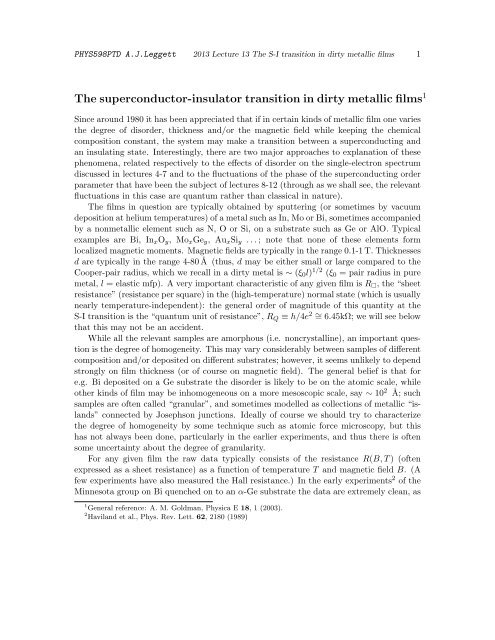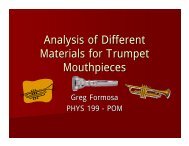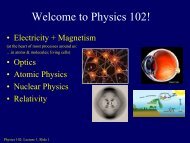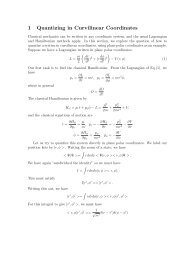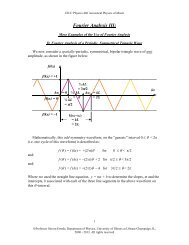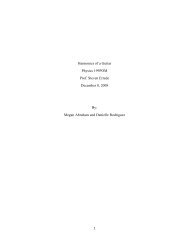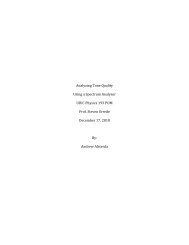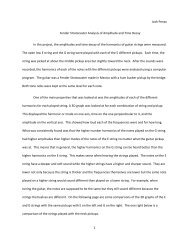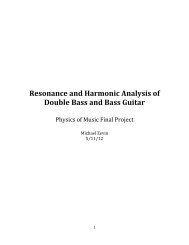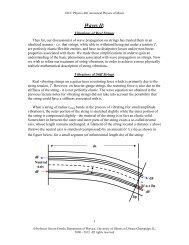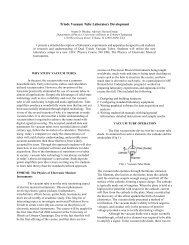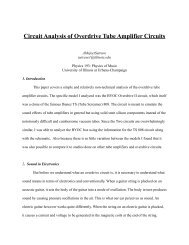The superconductor-insulator transition in dirty metallic films1
The superconductor-insulator transition in dirty metallic films1
The superconductor-insulator transition in dirty metallic films1
You also want an ePaper? Increase the reach of your titles
YUMPU automatically turns print PDFs into web optimized ePapers that Google loves.
PHYS598PTD A.J.Leggett 2013 Lecture 13 <strong>The</strong> S-I <strong>transition</strong> <strong>in</strong> <strong>dirty</strong> <strong>metallic</strong> films 1<br />
<strong>The</strong> <strong>superconductor</strong>-<strong><strong>in</strong>sulator</strong> <strong>transition</strong> <strong>in</strong> <strong>dirty</strong> <strong>metallic</strong> films 1<br />
S<strong>in</strong>ce around 1980 it has been appreciated that if <strong>in</strong> certa<strong>in</strong> k<strong>in</strong>ds of <strong>metallic</strong> film one varies<br />
the degree of disorder, thickness and/or the magnetic field while keep<strong>in</strong>g the chemical<br />
composition constant, the system may make a <strong>transition</strong> between a superconduct<strong>in</strong>g and<br />
an <strong>in</strong>sulat<strong>in</strong>g state. Interest<strong>in</strong>gly, there are two major approaches to explanation of these<br />
phenomena, related respectively to the effects of disorder on the s<strong>in</strong>gle-electron spectrum<br />
discussed <strong>in</strong> lectures 4-7 and to the fluctuations of the phase of the superconduct<strong>in</strong>g order<br />
parameter that have been the subject of lectures 8-12 (through as we shall see, the relevant<br />
fluctuations <strong>in</strong> this case are quantum rather than classical <strong>in</strong> nature).<br />
<strong>The</strong> films <strong>in</strong> question are typically obta<strong>in</strong>ed by sputter<strong>in</strong>g (or sometimes by vacuum<br />
deposition at helium temperatures) of a metal such as In, Mo or Bi, sometimes accompanied<br />
by a non<strong>metallic</strong> element such as N, O or Si, on a substrate such as Ge or AlO. Typical<br />
examples are Bi, In x O y , Mo x Ge y , Au x Si y . . . ; note that none of these elements form<br />
localized magnetic moments. Magnetic fields are typically <strong>in</strong> the range 0.1-1 T. Thicknesses<br />
d are typically <strong>in</strong> the range 4-80 Å (thus, d may be either small or large compared to the<br />
Cooper-pair radius, which we recall <strong>in</strong> a <strong>dirty</strong> metal is ∼ (ξ 0 l) 1/2 (ξ 0 = pair radius <strong>in</strong> pure<br />
metal, l = elastic mfp). A very important characteristic of any given film is R □ , the “sheet<br />
resistance” (resistance per square) <strong>in</strong> the (high-temperature) normal state (which is usually<br />
nearly temperature-<strong>in</strong>dependent): the general order of magnitude of this quantity at the<br />
S-I <strong>transition</strong> is the “quantum unit of resistance”, R Q ≡ h/4e 2 ∼ = 6.45kΩ; we will see below<br />
that this may not be an accident.<br />
While all the relevant samples are amorphous (i.e. noncrystall<strong>in</strong>e), an important question<br />
is the degree of homogeneity. This may vary considerably between samples of different<br />
composition and/or deposited on different substrates; however, it seems unlikely to depend<br />
strongly on film thickness (or of course on magnetic field). <strong>The</strong> general belief is that for<br />
e.g. Bi deposited on a Ge substrate the disorder is likely to be on the atomic scale, while<br />
other k<strong>in</strong>ds of film may be <strong>in</strong>homogeneous on a more mesoscopic scale, say ∼ 10 2 Å; such<br />
samples are often called “granular”, and sometimes modelled as collections of <strong>metallic</strong> “islands”<br />
connected by Josephson junctions. Ideally of course we should try to characterize<br />
the degree of homogeneity by some technique such as atomic force microscopy, but this<br />
has not always been done, particularly <strong>in</strong> the earlier experiments, and thus there is often<br />
some uncerta<strong>in</strong>ty about the degree of granularity.<br />
For any given film the raw data typically consists of the resistance R(B, T ) (often<br />
expressed as a sheet resistance) as a function of temperature T and magnetic field B. (A<br />
few experiments have also measured the Hall resistance.) In the early experiments 2 of the<br />
M<strong>in</strong>nesota group on Bi quenched on to an α-Ge substrate the data are extremely clean, as<br />
1 General reference: A. M. Goldman, Physica E 18, 1 (2003).<br />
2 Haviland et al., Phys. Rev. Lett. 62, 2180 (1989)
PHYS598PTD A.J.Leggett 2013 Lecture 13 <strong>The</strong> S-I <strong>transition</strong> <strong>in</strong> <strong>dirty</strong> <strong>metallic</strong> films 2<br />
shown <strong>in</strong> the figure. Th<strong>in</strong> films show a strong upturn <strong>in</strong> the resistance at low temperatures,<br />
apparently tend<strong>in</strong>g to an <strong>in</strong>sulat<strong>in</strong>g state <strong>in</strong> the limit T → 0, while thicker ones experience<br />
an abrupt decrease of resistance to an unobservably small value at a (thickness-dependent)<br />
temperature of a few K, <strong>in</strong>dicat<strong>in</strong>g a <strong>transition</strong> to the superconduct<strong>in</strong>g state. S<strong>in</strong>ce the<br />
dependence of the (<strong>in</strong>verse) sheet resistance R □ on thickness is presumably monotonic,<br />
one can say that films of high R □ become <strong>in</strong>sulat<strong>in</strong>g while those of lower R □ (higher<br />
conductance) become superconduct<strong>in</strong>g. Two very significant features of the data are that<br />
(1) no normal-<strong>metallic</strong> state appear to exist <strong>in</strong> the limit 3 T → 0, and (2) the “critical”<br />
normal-state sheet resistance R c which marks the separatrix between superconduct<strong>in</strong>g and<br />
<strong>in</strong>sulat<strong>in</strong>g behavior is very close to the quantum unit of resistance R Q . I postpone for the<br />
moment the question of the behavior <strong>in</strong> magnetic fields (which was not exam<strong>in</strong>ed <strong>in</strong> this<br />
particular set of experiments).<br />
2 A.M. Goldman / Physica E 18 (20<br />
Not all th<strong>in</strong> <strong>dirty</strong> <strong>metallic</strong> films show quite so<br />
clear-cut a behavior as a function of thickness and<br />
temperature as the above ones; for example, <strong>in</strong> some<br />
cases the behavior of R(T ) is nonmonotonic, and <strong>in</strong><br />
others it appears to flatten off as a function of T<br />
above the lowest temperature reached (typically ∼<br />
0.1 K), <strong>in</strong>dicat<strong>in</strong>g the possibility of a normal-<strong>metallic</strong><br />
state (<strong>in</strong> zero magnetic field) <strong>in</strong> the limit T → 0;<br />
this happens not only <strong>in</strong> some films that are probably<br />
granular, but even <strong>in</strong> some samples of Bi on<br />
Ge, and <strong>in</strong> this case the flatten<strong>in</strong>g persisted down to<br />
the much lower m<strong>in</strong>imum temperature of the experiment,<br />
less than 50 mK. This last data is fairly recent<br />
and probably needs further confirmation (cf. Goldman,<br />
op.cit.); it is of course not taken <strong>in</strong>to account <strong>in</strong><br />
the theoretical analyses that were conducted earlier.<br />
Turn<strong>in</strong>g now to possible <strong>in</strong>terpretations of the<br />
data, let’s start with an old and classic observation<br />
of Anderson: weak nonmagnetic disorder should<br />
not affect the superconduct<strong>in</strong>g <strong>transition</strong> qualitatively.<br />
<strong>The</strong> reason is that while the plane-wave states<br />
exp ik · r are no longer eigenstates of the s<strong>in</strong>gleparticle<br />
Hamiltonian, and hence cannot (at least prima<br />
facie) be used to form Cooper pairs, it is still possible<br />
to f<strong>in</strong>d pairs of exact eigenfunctions of the s<strong>in</strong>gleparticle<br />
Hamiltonian Ĥ0 ≡ − 2<br />
2m ∇2 + U(r) that are<br />
related to one another by time reversal. For example,<br />
if as is normally the case one can choose the<br />
Fig. 1. Evolution of the temperature dependence of the resistance<br />
R(T ) with thickness of a series of a-Bi lms deposited onto a-Ge.<br />
eigenfunctions of Ĥ0 to be real functions ϕ n (r) Fewer suchthan that half Ĥ0ϕ of the n (r) traces = are ɛ n ϕshown. n (r), Adapted then a from suit-Ref. [9].<br />
3 Assum<strong>in</strong>g that the curves very close to the separatrix turn up or down at a temperature below the<br />
lowest accessible <strong>in</strong> the experiment.<br />
of nite-size scal<strong>in</strong>g analyses support<strong>in</strong>g the existence of<br />
quantum critical po<strong>in</strong>ts separat<strong>in</strong>g superconduct<strong>in</strong>g and <strong>in</strong>sulat<strong>in</strong>g<br />
ground states are presented. Here lm thickness and<br />
magnetic eld are the tun<strong>in</strong>g parameters. <strong>The</strong> nal section<br />
considers a number of unresolved issues. <strong>The</strong>se <strong>in</strong>clude persistent<br />
evidence of the role of fermionic degrees of freedom,<br />
and more recent concerns relat<strong>in</strong>g to the nature of the ground<br />
states, the presence of <strong>metallic</strong> phases, and the role of discess<strong>in</strong>g.<br />
may be<br />
that is m<br />
and <strong>in</strong> m<br />
liquid h<br />
be at or<br />
the set o<br />
quench-<br />
1, with r<br />
conduct<br />
ance of<br />
complex<br />
atomic f<br />
are preorder<br />
is<br />
of the su<br />
mesosca<br />
ters as s<br />
although<br />
cal coup<br />
nectivity<br />
Most<br />
depositi<br />
duct<strong>in</strong>g<br />
perature<br />
dilution<br />
what can<br />
experim<br />
In x O y , M<br />
terizatio<br />
study th<br />
free of c<br />
ous con<br />
3. Scali<br />
transitio<br />
<strong>The</strong> p<br />
problem<br />
orig<strong>in</strong>all<br />
used to
PHYS598PTD A.J.Leggett 2013 Lecture 13 <strong>The</strong> S-I <strong>transition</strong> <strong>in</strong> <strong>dirty</strong> <strong>metallic</strong> films 3<br />
able choice of pairs would be simply (ϕ n , ↑) and (ϕ n , ↓) with ↑, ↓ the sp<strong>in</strong> eigenstates. One<br />
then forms the groundstate along the l<strong>in</strong>es of BCS, but replac<strong>in</strong>g the plane waves k ↑, −k ↓<br />
by (ϕ n , ↑), (ϕ n , ↓), i.e.<br />
Ψ 0 = ∏ (u n + v n a + n↑ a+ n↓<br />
)|vac〉 (1)<br />
n<br />
<strong>The</strong> subsequent calculations proceed exactly as <strong>in</strong> the orig<strong>in</strong>al BCS theory; s<strong>in</strong>ce the<br />
average s<strong>in</strong>gle-particle DOS near the Fermi energy is little affected by the disorder, and<br />
the (coarse-gra<strong>in</strong>ed) matrix elements V nn ′ for pair scatter<strong>in</strong>g do not vary much from the<br />
free-space elements V kk ′, it follows that the thermodynamic properties of the disordered<br />
system, <strong>in</strong>clud<strong>in</strong>g T c , are very close to those of the orig<strong>in</strong>al pure one. 4 (Of course, there<br />
may be substantial effects on quantities such as the superfluid density ρ s (T ) which relate<br />
to transport.)<br />
However, it is known that even <strong>in</strong> 3D sufficiently strong disorder will localize the s<strong>in</strong>gleparticle<br />
states near the Fermi energy; and we saw <strong>in</strong> lectures 4-7 that <strong>in</strong> 2D such localization<br />
<strong>in</strong>evitably occurs <strong>in</strong> the limit T → 0 however weak the disorder. So what happens to<br />
superconductivity at this po<strong>in</strong>t? In the normal phase the system is certa<strong>in</strong>ly an <strong><strong>in</strong>sulator</strong>;<br />
and it is extremely tempt<strong>in</strong>g to argue that even if Cooper pairs form from the localized<br />
s<strong>in</strong>gle-electron states, they will be, like these states, unable to propagate, and thus the<br />
paired system will rema<strong>in</strong> an <strong><strong>in</strong>sulator</strong>. Remarkably, this plausible conclusion turns out<br />
to be wrong! 5 <strong>The</strong> basic reason is that while the s<strong>in</strong>gle-particle wave functions no longer<br />
extend over the whole volume of the sample as <strong>in</strong> the pure metal, and hence <strong>in</strong> (e.g.) a r<strong>in</strong>g<br />
geometry cannot be affected by an AB flux, the two-particle (Cooper pair) wave function,<br />
regarded as a function of the COM variable, does so extend and thus is sensitive to an AB<br />
flux. So we get the remarkable prediction that <strong>in</strong> a 3D system <strong>in</strong> which <strong>in</strong> the absence of<br />
an attractive <strong>in</strong>teraction the disorder is sufficient to localize all the s<strong>in</strong>gle-particle states,<br />
switch<strong>in</strong>g on an attractive <strong>in</strong>teraction (e.g. due to the exchange of virtual phonons) will<br />
produce the follow<strong>in</strong>g result: at temperatures > some T 0 , where T 0 is generally speak<strong>in</strong>g<br />
of the order of the T c of the pure (non-disordered) system, the system will be a good<br />
<strong><strong>in</strong>sulator</strong>; however, the moment that T falls below T 0 it will become not just conduct<strong>in</strong>g<br />
but superconduct<strong>in</strong>g! Whether this state of affairs has been seen <strong>in</strong> exist<strong>in</strong>g experiments<br />
is debatable; 6 <strong>in</strong> any case it may be possible <strong>in</strong> future to verify (or refute) the prediction<br />
us<strong>in</strong>g ultracold Fermi atoms <strong>in</strong> a disordered optical lattice.<br />
In any case, one might guess that when the localization of the s<strong>in</strong>gle-particle states gets<br />
too strong, it might be energetically disadvantageous to form Cooper pairs at all. A very<br />
rough criterion might be that the energy spac<strong>in</strong>g of the s<strong>in</strong>gle-particle levels <strong>in</strong> a volume<br />
of the order of the localization length ξ loc becomes comparable to the bulk energy gap ∆ 0 ;<br />
4 If anyth<strong>in</strong>g, the “smooth<strong>in</strong>g” of the matrix elements by disorder tends to <strong>in</strong>crease T c.<br />
5 Bulaevskii and Sadovskii, JETP Lett. 39, 11 (1984); Ma and Lee, Phys. Rev. B 32, 5658 (1985)<br />
6 See Sadovskii, Phys. Rep. 282, 225 (1997).
PHYS598PTD A.J.Leggett 2013 Lecture 13 <strong>The</strong> S-I <strong>transition</strong> <strong>in</strong> <strong>dirty</strong> <strong>metallic</strong> films 4<br />
<strong>in</strong> 2D this would then give us the condition for the destruction of superconductivity<br />
ξ 2 loc <br />
2<br />
2m∆ 0<br />
∼ k −1<br />
F ξ 0 (2)<br />
where ξ 0 is the Cooper-pair radius <strong>in</strong> the pure material. S<strong>in</strong>ce <strong>in</strong> a 2D system the<br />
localization length is exponentially large ( O ( l exp(k F l) ) even at T → 0 ) , it seems unlikely<br />
that this <strong>transition</strong> would be experimentally accessible, except perhaps <strong>in</strong> the very dirtiest<br />
materials.<br />
Unfortunately, as always <strong>in</strong> the localization problem, it turns out that this consideration<br />
is anyway too simple: one needs to take <strong>in</strong>to account the <strong>in</strong>terplay of disorder and<br />
<strong>in</strong>teraction effects which, as discussed <strong>in</strong> lecture 7, changes the low-energy s<strong>in</strong>gle-particle<br />
energy spectrum qualitatively. <strong>The</strong> ensu<strong>in</strong>g calculations, for which field-theoretic methods<br />
are unavoidable, are discussed <strong>in</strong> detail by F<strong>in</strong>kelste<strong>in</strong>. 7 Without go<strong>in</strong>g <strong>in</strong>to the details, we<br />
note (a) that the primary physical affect responsible for the suppression and eventual destruction<br />
of superconductivity <strong>in</strong> this approach turns out to be that s<strong>in</strong>ce a pair of electrons<br />
moves diffusively rather than ballistically, the repulsive Coulomb <strong>in</strong>teraction is enhanced<br />
and, of course, tends to <strong>in</strong>hibit Cooper pair formation (b) at least for elastic mean free<br />
path l ≪ d (thickness of film) (so that the system is “locally” 3D) the depression of T c<br />
relative to its value T c0 for the pure material is given <strong>in</strong> perturbation theory by the formula<br />
ln(T c /T c0 ) = −e2<br />
6π 2 g 1R □ (ln 1/T c τ) 3 (3)<br />
where τ is the normal-state elastic scatter<strong>in</strong>g time, R □ is as above the normal-state<br />
sheet resistance and g 1 is a dimensionless parameter characteriz<strong>in</strong>g the screened Coulomb<br />
<strong>in</strong>teraction. Evidently this formula does not lead to suppression of T c to zero for any value<br />
of τ, so it cannot by itself describe the S-I <strong>transition</strong>. A more sophisticated renormalizationgroup<br />
calculation, however, does predict that superconductivity vanishes (and hence the<br />
system presumably reverts to the <strong>in</strong>sulat<strong>in</strong>g state) when<br />
(e 2 /2π)R □ ∼ (1/ ln T c0 τ) 2 (4)<br />
Note that s<strong>in</strong>ce R □ and τ are <strong>in</strong>dependent variables, the S-I <strong>transition</strong> does not occur<br />
at a universal value of R □ .<br />
<strong>The</strong> po<strong>in</strong>t to stress about the above approach is that it is essentially a theory of the<br />
conditions under which local Cooper pair<strong>in</strong>g is or is not favorable. <strong>The</strong> thermodynamics<br />
is thus very similar to that <strong>in</strong> the orig<strong>in</strong>al BCS theory, and <strong>in</strong> particular it unambiguously<br />
predicts that the s<strong>in</strong>gle-particle energy gap ∆ (which can be measured, at least <strong>in</strong> pr<strong>in</strong>ciple,<br />
by e.g. tunnell<strong>in</strong>g or specific heat measurements) should scale with T c just as <strong>in</strong> that theory<br />
and thus approach zero as we approach the S-I <strong>transition</strong> from the S side. Another way<br />
7 F<strong>in</strong>kelste<strong>in</strong>, Physica B 197, 636 (1994).
PHYS598PTD A.J.Leggett 2013 Lecture 13 <strong>The</strong> S-I <strong>transition</strong> <strong>in</strong> <strong>dirty</strong> <strong>metallic</strong> films 5<br />
of putt<strong>in</strong>g it is that <strong>in</strong> this approach the reason superconductivity is destroyed by disorder<br />
is that the amplitude of the order parameter Ψ(r) is driven to zero, not that its phase<br />
fluctuates as <strong>in</strong> the KT <strong>transition</strong>.<br />
An alternative, very different approach to the S-I <strong>transition</strong> <strong>in</strong> th<strong>in</strong> <strong>dirty</strong> <strong>metallic</strong> films is<br />
based on the idea that the superconduct<strong>in</strong>g order parameter is locally def<strong>in</strong>ed throughout<br />
the whole of the parameter space, but that while <strong>in</strong> the S phase it possesses long-rang<br />
phase coherence (LRO), on the I side of the <strong>transition</strong> the phase fluctuates so wildly<br />
(due to quantum, not thermal affects) that no LRO is possible and the system becomes<br />
<strong>in</strong>sulat<strong>in</strong>g. Thus, the S-I <strong>transition</strong> qualitatively resembles the KT <strong>transition</strong> which, as<br />
we saw <strong>in</strong> lecture 12, is believed to occur <strong>in</strong> helium films and also <strong>in</strong> some (less <strong>dirty</strong>) 2D<br />
<strong>metallic</strong> films. However, <strong>in</strong> the present case the <strong>transition</strong> does not occur <strong>in</strong> a given film as a<br />
function of temperature, but rather occurs at or close to zero T as a function of parameters<br />
such as thickness and sheet resistance (i.e. disorder). It is thus an example of a quantum<br />
phase <strong>transition</strong> (QPT), that is a phase <strong>transition</strong> that occurs at zero temperature as one<br />
or more parameters of the system are varied. We need, therefore, to explore the general<br />
theory of such <strong>transition</strong>s a little. 8<br />
QPT’s can of course occur <strong>in</strong> any number of (spatial) dimensions, <strong>in</strong>clud<strong>in</strong>g zero (see<br />
below), so the problem they pose is not restricted to d = 2. Exact analytic results can be<br />
obta<strong>in</strong>ed <strong>in</strong> only a small number of cases, of which the best known is the 1D Is<strong>in</strong>g model <strong>in</strong><br />
a transverse field. Where no analytic solution is available, the theory of QPTs relies heavily<br />
on mapp<strong>in</strong>g the d-dimensional quantum problem to an equivalent d+1-dimensional classical<br />
problem and then us<strong>in</strong>g the large body of results which have been obta<strong>in</strong>ed over the last 40<br />
years concern<strong>in</strong>g (classical) second-order phase <strong>transition</strong>s. Let’s illustrate this procedure<br />
with a particularly simple example, namely a 2D Josephson junction array. We already<br />
looked briefly, <strong>in</strong> lecture 12, at the experimental results on this system <strong>in</strong> a particular limit<br />
(see below) and saw that they are consistent with the hypothesis that it susta<strong>in</strong>s a KT<br />
<strong>transition</strong> at a f<strong>in</strong>ite temperature determ<strong>in</strong>ed by the strength E J (≡ J) of the Josephson<br />
coupl<strong>in</strong>g. A po<strong>in</strong>t that will be essential <strong>in</strong> the arguments below is that the important length<br />
scales <strong>in</strong>volved <strong>in</strong> the KT <strong>transition</strong> (ξ ± ) diverge <strong>in</strong> the limit T → T KT , which means that<br />
the “bend<strong>in</strong>g” of the OP phase <strong>in</strong> the relevant region is very gentle and the system cannot<br />
tell the difference between the actual Hamiltonian, which refers to discrete gra<strong>in</strong>s, and a<br />
simple cont<strong>in</strong>uum such as would be realized by a 4 He film. (Technically, these two different<br />
systems are said to belong to the same “universality class.”)<br />
<strong>The</strong> Hamiltonian of the Josephson junction array was taken <strong>in</strong> lecture 12 to consist<br />
only of a potential energy that depends on the relative phase of the OP on neighbor<strong>in</strong>g<br />
dots:<br />
∑<br />
V = E J cos(ϕ i − ϕ j ) (5)<br />
ij=n.n.<br />
8 For a readable short review of QPT’s, see Sondhi et al., RMP 69, 315 (1997), or for a more extended<br />
discussion, S. Sachdev, Quantum Phase Transitions.
PHYS598PTD A.J.Leggett 2013 Lecture 13 <strong>The</strong> S-I <strong>transition</strong> <strong>in</strong> <strong>dirty</strong> <strong>metallic</strong> films 6<br />
where E j is (<strong>in</strong> zero external magnetic field) a positive constant. For small phase<br />
drops ϕ i − ϕ j between nearest neighbors, (5) is equivalent to a cont<strong>in</strong>uum model with an<br />
equaivalent superfluid density ρ s0 (T ) given by<br />
ρ s0 (T ) = (2m/) 2 E J (6)<br />
(note that the spac<strong>in</strong>g of the dots does not enter). <strong>The</strong> order of magnitude of T KT<br />
is therefore 9 , perhaps unsurpris<strong>in</strong>gly, E J . Note that this means that for T ∼ T KT the<br />
mean-square value of ϕ i − ϕ j is not very small, so that the problem must be handled<br />
self-consistently and the difference between ρ s0 and ρ s may be substantial. However, this<br />
does not affect the crucial po<strong>in</strong>t that the critical behavior at T KT is sensitive only to<br />
configurations <strong>in</strong> which |ϕ i − ϕ j | ≪ 1.<br />
<strong>The</strong> above discussion is appropriate to “classical” Josephson junction arrays, by which<br />
we mean arrays <strong>in</strong> which the dots are large enough, and the <strong>in</strong>ter-dot Josephson coupl<strong>in</strong>g<br />
E J strong enough, that E J ≫ E c , where E c ≡ (2e)2<br />
2C<br />
is the capacitive energy necessary to<br />
transfer a Cooper pair from one dot to its neighbor. However, for small dots and/or weak<br />
Josephson coupl<strong>in</strong>g E c may be comparable to or even much larger than E J . What is the<br />
form of the relevant term <strong>in</strong> the Hamiltonian? <strong>The</strong>re are a number of ways of deriv<strong>in</strong>g<br />
it, of which the simplest is probably to note that the voltage V ij between a pair i, j of<br />
neighbor<strong>in</strong>g dots is given <strong>in</strong> terms of the time derivative of ∆ϕ ij by the second Josephson<br />
equation<br />
V ij = d<br />
2e dt (∆ϕ ij) (7)<br />
Thus, for a s<strong>in</strong>gle pair of dots (∆ϕ ij → ϕ) the total Hamiltonian can be written<br />
(Φ o ≡ h/2e = superconduct<strong>in</strong>g flux quantum)<br />
Ĥ = 1 2 CV 2 − E J cos ϕ = 1 ( ) 2<br />
2 C Φ0<br />
˙ϕ 2 − E J cos ϕ (8)<br />
2π<br />
To express Ĥ <strong>in</strong> terms of ϕ and its canonically conjugate momentum p ϕ, we def<strong>in</strong>e<br />
p ϕ ≡ ∂T/∂ ˙ϕ = C(Φ 0 /2π) 2 ˙ϕ, which from (7) is just (Φ 0 /2π) times CV = Q, the charge<br />
transferred across the junction; the “k<strong>in</strong>etic energy” T (the first term <strong>in</strong> (8)) is then just<br />
p 2 ϕ/(2C ( Φ 0 /2π) 2) ≡ Q 2 /2C. However, it will actually be more convenient for our purposes<br />
to keep the Hamiltonian <strong>in</strong> the (non-canonical) form (8), i.e. to regard it as a function of<br />
ϕ and ˙ϕ rather than of ϕ and p ϕ .<br />
<strong>The</strong> Hamiltonian (8) of a s<strong>in</strong>gle pair of dots connected by a Josephson junction is<br />
noth<strong>in</strong>g but that of a simple quantum pendulum, with the quantity E J correspond<strong>in</strong>g<br />
to the gravitational potential and the quantity C(Φ 0 /2π) 2 play<strong>in</strong>g the role of moment of<br />
9 Of course E J may itself be temperature-dependent, but such dependence is likely to be on the scale<br />
of the bulk 3D BCS <strong>transition</strong> temperature T c0, which <strong>in</strong> real life is typically ≫ E J(T = 0); thus it may<br />
safely be neglected <strong>in</strong> the present context.
PHYS598PTD A.J.Leggett 2013 Lecture 13 <strong>The</strong> S-I <strong>transition</strong> <strong>in</strong> <strong>dirty</strong> <strong>metallic</strong> films 7<br />
<strong>in</strong>ertia. A simple analysis shows that <strong>in</strong> the limit E c ≪ E J the groundstate of the system<br />
has ϕ close to zero and the low excited states are harmonic-oscillator-like with frequency<br />
ω J ≡ √ E J E c /, while for E c ≫ E J the groundstate is approximately the state of zero<br />
angular momentum (i.e. uniform with respect to ϕ) and excited states are rotor-like. For<br />
<strong>in</strong>termediate values of K ≡ E c /E J the problem can be solved to high accuracy by numerical<br />
methods, and it is found that the crossover is smooth as a function of K.<br />
Let’s now return to our 2D array. From the above considerations, the Hamiltonian,<br />
<strong>in</strong>clud<strong>in</strong>g capacitance effects, can be written <strong>in</strong> the form<br />
Ĥ =<br />
∑ { }<br />
1<br />
2 C(Φ 0/2π) 2 ˙ϕ 2 ij − E J cos ϕ ij (ϕ ij ≡ ϕ i − ϕ j ) (9)<br />
ij=n.n.<br />
Let us consider the partition function<br />
Z(β) ≡ Tr exp −βĤ (β ≡ 1/k BT ) (10)<br />
In pr<strong>in</strong>ciple, if we can write Z as a function not only of β but of arbitrary “external<br />
source” terms, then by differentiat<strong>in</strong>g with respect to these source terms we can obta<strong>in</strong> the<br />
expectation value, <strong>in</strong> thermal equilibrium, of an arbitrary (time-<strong>in</strong>dependent) operator. So<br />
it conta<strong>in</strong>s complete <strong>in</strong>formation about all the static properties of the system.<br />
Before proceed<strong>in</strong>g, we need to dispose of one technical po<strong>in</strong>t: Let’s write ϕ ij ≡ ϕ i − ϕ j ,<br />
so that the “k<strong>in</strong>etic energy” term <strong>in</strong> (9) becomes<br />
T = 1 2 C(Φ 0/2π) ∑ 2 ( ˙ϕ 2 i + ˙ϕ 2 j − 2 ˙ϕ i ˙ϕ j ) (11)<br />
<strong>The</strong> last term has the form<br />
ij=nn<br />
( ∑<br />
const.<br />
i<br />
˙ϕ i<br />
) 2<br />
= const.<br />
V i<br />
) 2<br />
(12)<br />
( ∑<br />
i<br />
It is clear that this term can always be elim<strong>in</strong>ated by a suitable choice of the zero of voltage<br />
(electrochemical potential). Hence we can legitimately write<br />
T = 1 2 ˜C(Φ 0 /2π) 2 ∑ i<br />
˙ϕ 2 i (13)<br />
where ˜C = 2zC, z = number of nearest neighbors. We will use this form rather than that<br />
<strong>in</strong> (9) below.<br />
It is well known that whether the system is quantum or classical, the partition function<br />
can be written <strong>in</strong> path-<strong>in</strong>tegral form <strong>in</strong> “imag<strong>in</strong>ary time” τ (we suppress any dependence<br />
on external source terms):<br />
Z(β) = ∏ ∫<br />
∫ β<br />
Dϕ i (τ) exp − H [ϕ i (τ)] dτ/ (14)<br />
i<br />
0
PHYS598PTD A.J.Leggett 2013 Lecture 13 <strong>The</strong> S-I <strong>transition</strong> <strong>in</strong> <strong>dirty</strong> <strong>metallic</strong> films 8<br />
Formula (14) is exact. When the temperature is high compared to the relevant characteristic<br />
frequencies ω of the system, so that ωτ ≪ 1 over the whole range O < τ < β, there<br />
is no “time” for fluctuations of ϕ i as a function of τ to occur, and they may be set equal to<br />
their values at say τ = 0; the “k<strong>in</strong>etic energy” term ( the first term <strong>in</strong> (9) ) now contributes<br />
at most an un<strong>in</strong>terest<strong>in</strong>g constant, and we can replace (14) by the classical expression<br />
Z el (β) = ∏ ∫<br />
Dϕ i exp −βV {ϕ ij } (15)<br />
i<br />
Now comes the nontrivial “trick”. We <strong>in</strong>sert the full quantum expression (9), with<br />
the replacement (13), <strong>in</strong>to (14) and postulate that for the purposes of deriv<strong>in</strong>g the critical<br />
behavior the important imag<strong>in</strong>ary-time trajectories have the property that the “gradients”<br />
of the ϕ i are “small,” not just <strong>in</strong> space but also <strong>in</strong> (imag<strong>in</strong>ary) time, <strong>in</strong> the sense that<br />
ϕ i (τ + ∆τ) − ϕ i (τ) ≪ 1 when ∆τ is an appropriate small time <strong>in</strong>terval (to be def<strong>in</strong>ed<br />
below). We then discretize the <strong>in</strong>tegral <strong>in</strong> the exponent of (14), replac<strong>in</strong>g the cont<strong>in</strong>uous<br />
variable τ by a set of discrete values τ n ≡ n∆τ, so that consider<strong>in</strong>g the n, n + 1 pair of<br />
times and the phase ϕ i<br />
T = (const.) (∆τ) −2( ϕ i (τ n+1 ) − ϕ i (τ n ) ) 2<br />
(16)<br />
∼= const. − const. 2 (∆τ) −2( cos {ϕ i (τ n+1 ) − ϕ i (τ n )} )<br />
Hence the exponent S of the functional <strong>in</strong>tegral <strong>in</strong> (14) takes the discretized form<br />
S = −1{ ∑ ∑<br />
(− 1 )<br />
2 ˜C(Φ 0 /2π) 2 (∆τ) −1 cos [ ϕ i (τ n+1 ) − ϕ(τ n ) ]<br />
n<br />
i<br />
−E J ∆τ<br />
∑<br />
ij=n.n.<br />
cos [ ]} (17)<br />
ϕ i (τ n ) − ϕ j (τ n )<br />
It is clear that the structure of the two terms is exactly the same. In fact, if we make the<br />
specific choice ∆τ = / √ E J E c where E c now ≡ (2e) 2 /2 ˜C and remember that ∆τ = β/L τ<br />
where L τ is the number of “time” steps, we can write<br />
⎧<br />
⎫<br />
S = − 1 ⎨∑<br />
cos ( ϕ i (τ n+1 − ϕ(τ n ) ) + ∑<br />
cos ( ϕ i (τ n ) − ϕ j (τ n ) ) ⎬<br />
(18)<br />
K ⎩<br />
⎭<br />
where<br />
i,n<br />
ij=nn<br />
K ≡ (E c /E J ) 1/2 (19)<br />
We can now change the notation so that ϕ i (τ n ) → ϕ <strong>in</strong> and the functional <strong>in</strong>tegral (14)<br />
then takes the discretized form<br />
⎧<br />
⎫<br />
Z(β) → ∏ ∫<br />
Dϕ i,n exp − 1 ⎨<br />
K ⎩ − ∑ cos(ϕ i,n+1 − ϕ i,n ) −<br />
∑<br />
⎬<br />
cos(ϕ i,n − ϕ j,n )<br />
⎭ (20)<br />
i,n<br />
<strong>in</strong><br />
ij=n.n.
PHYS598PTD A.J.Leggett 2013 Lecture 13 <strong>The</strong> S-I <strong>transition</strong> <strong>in</strong> <strong>dirty</strong> <strong>metallic</strong> films 9<br />
But this is noth<strong>in</strong>g but the classical partition function of a 3-dimensional array of Josephson<br />
junctions, with the quantity K play<strong>in</strong>g the role of k B T/E j and the physical temperature β<br />
now play<strong>in</strong>g the role of the “width” L τ (number of sites) <strong>in</strong> the third dimension! Thus we<br />
can immediately read off some of the properties of the 2D zero-temperature QPT from our<br />
knowledge of the behavior of the 3D classical phase <strong>transition</strong> of the XY-model ( s<strong>in</strong>ce this is<br />
just the model described by (18) ) . In particular, s<strong>in</strong>ce we know that <strong>in</strong> the thermodynamic<br />
limit the 3D XY model has a phase <strong>transition</strong> from an ordered to a disordered state at a<br />
value of k B T/E J ∼ 1, it follows that at zero temperature (L τ → ∞) the quantum model<br />
should have a similar <strong>transition</strong> at a value of K ∼ 1. (However, we cannot necessarily<br />
identify the constant factors <strong>in</strong> the two cases, s<strong>in</strong>ce these may be senstive to short-range<br />
effects for which the replacement (16) need not be valid.) Moreover, as K approaches the<br />
value of K c , we expect a divergence of the characteristic length scale which is identical <strong>in</strong><br />
form to that of the 3D XY model for T → T c ; <strong>in</strong> fact, if<br />
then at the 2D QPT ξ 2D (K) should diverge <strong>in</strong> the same way:<br />
ξ 3D (T ) → |T − T c | −ν (21)<br />
ξ 2D (K) (T =0) → |K − K c | −ν . (22)<br />
For the 3D XY model both theory and experiment (on superfluid 4 He) suggest that ν is<br />
close to 2/3.<br />
It should be cautioned that we could make this specially simple correspondence between<br />
the zero-temperature d-dimensional QPT and the (f<strong>in</strong>ite-T ) d+1-dimensional classical one<br />
only because we could argue that for the trajectories which play the crucial role <strong>in</strong> the <strong>transition</strong><br />
the form of the “time-axis” <strong>in</strong>teractions is approximately the same as the “space-axis”<br />
ones, namely cos(ϕ n − ϕ n+1 ). This feature is not generic to QPT’s; it is essentially equivalent<br />
to the statement that for the classical phase <strong>transition</strong> the exponents of the divergent<br />
correlation length ξ and the divergent correlation time ξ τ , which are conventionally called<br />
ν and zν respectively, i.e.<br />
ξ ∼ |T − T c | −ν<br />
(23a)<br />
ξ τ ∼ |T − T c | −zν<br />
(23b)<br />
are the same, i.e. z = 1. If the classical d + 1-dimensional phase <strong>transition</strong> does not satisfy<br />
this condition the relation to the quantum d-dimensional <strong>transition</strong> is more complicated.<br />
For values of K much less than K c our 2D Josephson junction array is clearly qualitatively<br />
similar to the 3D array well below T c , i.e. it possesses LRO (remember, we are for<br />
the moment at T = 0, so the HMW theorem does not forbid this!) and behaves as a superfluid.<br />
What is the nature of the phase which occurs at values of K greater than K c ? Here<br />
the analogy with the classical <strong>transition</strong> is less useful, s<strong>in</strong>ce the latter automatically occurs
PHYS598PTD A.J.Leggett 2013 Lecture 13 <strong>The</strong> S-I <strong>transition</strong> <strong>in</strong> <strong>dirty</strong> <strong>metallic</strong> films 10<br />
at f<strong>in</strong>ite T where there are already many excitations. However, explicit consideration of<br />
a similar model, the Bose alkali gas <strong>in</strong> an optical lattice, suggests that this phase has a<br />
def<strong>in</strong>ite number of particles (<strong>in</strong> our case Cooper pairs) on each lattice site (dot); unless we<br />
are close to K c such a phase should have an energy gap of the order of the capacitance<br />
energy E c , and thus at zero temperature should be <strong>in</strong>sulat<strong>in</strong>g. Thus the <strong>transition</strong> we have<br />
discovered <strong>in</strong> the 2D Josephson junction array might plausibly be regarded as correspond<strong>in</strong>g<br />
to the <strong>superconductor</strong>-<strong><strong>in</strong>sulator</strong> <strong>transition</strong> observed experimentally <strong>in</strong> th<strong>in</strong> fiilms, at<br />
least those of sufficient granularity.<br />
What can we say about the behavior of the<br />
T T KT<br />
T<br />
system at nonzero temperatures and K close to<br />
crossover<br />
K c ? Actually, scal<strong>in</strong>g considerations help us quite<br />
normal<br />
a bit. Consider first the general nature of the<br />
phase diagram. We know that for K ≪ K c we<br />
have (except very close to zero temperature) a<br />
2D classical XY model, which has a KT <strong>transition</strong>,<br />
at a temperature ∼ E J , from a phase with<br />
(topological) LRO to a “normal” phase. So there<br />
superfluid<br />
K c<br />
<strong>in</strong>sulat<strong>in</strong>g<br />
must be a phase boundary (locus of second-order <strong>transition</strong>s) <strong>in</strong> the K-T plane. Also, we<br />
know that at T = 0 the “disordered” phase is an <strong><strong>in</strong>sulator</strong> while at high T (cross<strong>in</strong>g over<br />
from the KT <strong>transition</strong>) it is a normal “liquid”; hence there must be a rough separatrix <strong>in</strong><br />
the K-T plane between normal-<strong>metallic</strong> and <strong>in</strong>sulat<strong>in</strong>g behavior; however, this could be a<br />
smooth crossover s<strong>in</strong>ce no symmetry is broken on either side and the resistivity is expected<br />
to be cont<strong>in</strong>uous. Qualitatively, we should expect this crossover to occur at a temperature<br />
T (K) ∼ ∆(K) where ∆ is the excitation gap at zero temperature. Anticipat<strong>in</strong>g the result<br />
that ∆(K) → 0 for K → K c (see below) we therefore f<strong>in</strong>d the phase diagram should look<br />
qualitatively like shown <strong>in</strong> the figure. Let’s try to be a bit more quantitative. We recall<br />
that the length along the “time” axis, L τ , is proportional to the <strong>in</strong>verse temperature β.<br />
Thus, as temperature <strong>in</strong>creases, L τ decreases. We should expect that the behavior changes<br />
qualitatively at the po<strong>in</strong>t where L τ becomes of the order of ξ τ<br />
(<br />
∼ ξ for our (z = 1) case<br />
)<br />
for the 3D problem; beyond this, the classical “3D” problem becomes that of a “slab” of<br />
thickness < ξ τ , whose behavior we should expect to be essentially 2D. This criterion gives a<br />
critical temperature (for K < K c ) T KT (K) of order ξ −1<br />
3D (K), and s<strong>in</strong>ce ξ 3D ∼ |(K − K c )| −ν<br />
we f<strong>in</strong>d<br />
T KT (K) = const.(K c − K) ν (24)<br />
A similar argument on the <strong>in</strong>sulat<strong>in</strong>g side shows that the crossover temperature (which is<br />
only def<strong>in</strong>ed up to an order of magnitude) should satisfy<br />
T crossover (K) = const.(K − K c ) ν . (25)<br />
Hence the phase diagram is roughly as shown <strong>in</strong> the figure: s<strong>in</strong>ce for our case ν < 1, there<br />
K
PHYS598PTD A.J.Leggett 2013 Lecture 13 <strong>The</strong> S-I <strong>transition</strong> <strong>in</strong> <strong>dirty</strong> <strong>metallic</strong> films 11<br />
Sondhi et al.: Cont<strong>in</strong>uous quantum phase <strong>transition</strong>s<br />
is a cusp at the QCP T = 0, K = K c .<br />
the dynamical exponent Although z1. we<strong>The</strong>n have the worked Fourier out this scenario<br />
rm of the correlation for the particular function case offor a 2Dthe<br />
JJ array (which<br />
-dimensional problem happens is to correspond to z = 1), it should be<br />
qualitatively valid for an arbitrary second-order<br />
k, n k 2 2 n QPT, 2 with d1, the proviso that while (19) the separatrices<br />
T<br />
the (d1)st component 0 still satisfy the criterion L<br />
of the ‘‘wave vector’’ τ ∼ ξ<br />
is τ , the quantity<br />
ξ<br />
the Matsubara frequency τ <strong>in</strong> general scales like |K − K<br />
used to Fourier transthe<br />
time direction. Analytic cont<strong>in</strong>uation to real<br />
c | −zν (where K is<br />
now a general control parameter), and so we have<br />
cies via the usual prescription T 0 (K) ∼(Mahan, const. |K1990)<br />
− K c | zν . (26)<br />
i yields the retarded We can correlation actually go function somewhat further. Consider<br />
a physical 2 2 quantity d1 /2 . such as (20) the dc resistivity<br />
k,ik 2 i<br />
R, as a function of K and T . S<strong>in</strong>ce this corre-<br />
frequency to k = ofω some = 0, itcoherently<br />
does not by itself def<strong>in</strong>e<br />
of a pole at thesponds<br />
<strong>in</strong>g collective mode, a length we or time seescale. <strong>in</strong>stead Hence it that must be a function<br />
only cut of forthe frequencies ratio of theabove<br />
two “large” lengths<br />
i) has a branch<br />
we have implicitly <strong>in</strong> set the the problem, characteristic namely ξ τ<br />
velocity and L τ . S<strong>in</strong>ce L τ ∼ T −1 and ξ τ ∼ |K − K c | −νz , it follows that<br />
). Thus we see that (δ ≡there K − Kis c no ) characteristic freother<br />
than k itself [<strong>in</strong> general, k z as <strong>in</strong> Eq. (16)], R(δ, T ) junction = R c f (δ array · T −1/νz <strong>in</strong> two ) dimensions. K is the quantum-fluctuation<br />
(27)<br />
FIG. 5. Illustration of the phase diagram for a Josephson-<br />
discussed above. This implies that collective parameter, and T is the physical temperature. <strong>The</strong> solid l<strong>in</strong>e<br />
where R c may be taken as the resistivity exactly at the QCP. Of course, the function f<br />
have become overdamped, and the system is <strong>in</strong> represents the Kosterlitz-Thouless critical temperature for the<br />
could have a different form on the two sides of the <strong>transition</strong>.<br />
herent diffusive regime. <strong>The</strong> review by Sachdev phase <strong>transition</strong> from the normal state to the superfluid. <strong>The</strong><br />
This result should hold irrespective of the nature of the control parameter. It turns<br />
s some specific examples that nicely illustrate solid l<strong>in</strong>e ends at the quantum critical po<strong>in</strong>t (QCP), where the<br />
out that a similar scal<strong>in</strong>g relation can be derived for the dependence on the electric field<br />
o<strong>in</strong>ts (Sachdev, 1996).<br />
critical temperature goes to zero. For K greater than its critical<br />
applied across the sample<br />
ly, three comments are <strong>in</strong> order. First, as we saw<br />
value, the system is <strong>in</strong>sulat<strong>in</strong>g at zero temperature. For any<br />
xample of the Josephson-junction array, a f<strong>in</strong>ite R c (δ, E) = f<strong>in</strong>ite R c f(δ temperature · E −1/ν(z+1) it) is not <strong>in</strong>sulat<strong>in</strong>g. <strong>The</strong> dashed (28) l<strong>in</strong>e represents<br />
the crossover from temperatures smaller than the<br />
al correlation length<br />
We<br />
means<br />
now<br />
that<br />
return<br />
there<br />
to the<br />
is<br />
experimental<br />
a gap <strong>in</strong><br />
(T0 situation. <strong>in</strong>sulat<strong>in</strong>g) <strong>The</strong> S-I gap <strong>transition</strong> to temperatures <strong>in</strong> th<strong>in</strong> <strong>metallic</strong> greater films than the gap.<br />
ctrum of the quantum<br />
can be<br />
problem.<br />
tuned by<br />
Conversely,<br />
thickness, disorder<br />
critiems<br />
are gapless. Second, field or electric the exponent field. Some z is aofmea-<br />
the data, can for be example expected those to taken <strong>in</strong>crease on amorphous rapidly as the Bi grown temperature goes<br />
(ifThis we believe is not athat trueisphase a different <strong>transition</strong>; variable), however, magnetic the conductivity<br />
how skewed time on an is, α-Ge relative substrate to space, fit the<strong>in</strong>scal<strong>in</strong>g the relation above(27) this l<strong>in</strong>e. beautifully; see Goldman, ref. cit., fig.<br />
region. This does2. not, S<strong>in</strong>ce a these priori, experiments have anyth<strong>in</strong>g measure to νz while the scal<strong>in</strong>g with electric field (also observed)<br />
what happens <strong>in</strong> measures either ν(z of +1), the phases. one can extract For ex-thone should resistthat the the temptation best valuestoarededuce the <strong>in</strong>g QPT <strong>in</strong> any system. As the experimentally accessible<br />
values of ν and z <strong>in</strong>dependently; Goldman concludes<br />
f z via q z from the dispersion of any Goldode<br />
21<br />
= 2/3) (29)<br />
z = 1, behavior ν = 0.7( ∼ of the system necessarily <strong>in</strong>volves a nonzero<br />
<strong>in</strong> the ordered phase. This is <strong>in</strong>correct<br />
<strong>The</strong>se are to a good approximation the temperature, values that would we need be expected to understand (cf. above) howifto themodify the<br />
e exponent z is a property of the critical po<strong>in</strong>t<br />
effective control parameters were the ratio scal<strong>in</strong>g (E c /E forms J ) of the previous section for the T 0 problem.<br />
that the thickness of the film, still less the<br />
ot of the ordered phase. Third, we should restate<br />
1/2 . However, this observation raises<br />
some questions, s<strong>in</strong>ce it is not at all obvious<br />
ll-known wisdom<br />
magnetic<br />
that the<br />
field,<br />
diverg<strong>in</strong>g<br />
is particularly<br />
lengths<br />
strongly<br />
and<br />
correlated <strong>The</strong> crucial with this observation ratio. . . for this purpose is, as noted<br />
ociated scal<strong>in</strong>g of physical quantities are particuterest<strong>in</strong>g<br />
because they represent universal behav- tak<strong>in</strong>g T 0 <strong>in</strong> the partition function of Eq. (5) is to<br />
earlier and illustrated <strong>in</strong> Fig. 4, that the only effect of<br />
., behavior <strong>in</strong>sensitive to microscopic details make the temporal dimension f<strong>in</strong>ite; <strong>in</strong> particular, there<br />
certa<strong>in</strong> global constra<strong>in</strong>ts such as symmetry and is no change <strong>in</strong> the coupl<strong>in</strong>g K with physical temperature.<br />
<strong>The</strong> effective classical system now resembles a hy-<br />
ionality (Goldenfeld, 1992).<br />
perslab with d spatial dimensions (taken to be <strong>in</strong>f<strong>in</strong>ite <strong>in</strong><br />
extent) and one temporal dimension of size L . As<br />
phase <strong>transition</strong>s depend sensitively upon the dimensionality<br />
of the system, we expect the f<strong>in</strong>iteness of L to<br />
0: F<strong>in</strong>ite-size scal<strong>in</strong>g<br />
modify the critical behavior, s<strong>in</strong>ce at the longest length


